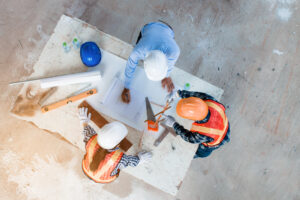The manufacturing industry has long been characterized by its assembly line-style factory layout design. Improving the safety of factory workers has been a focus in recent years, which led to a shift in factory layout design. By rethinking the layout, it is possible to create a safer working environment for employees, reduce the risk of accidents, and increase productivity.
Let’s go through 10 factors you need to have in mind while (re)designing a factory layout:
1. Optimize floor space to create safe work areas
One of the most important factors to consider when designing a factory layout is the flow of materials and people. The layout should be designed in a way that allows easy movement of materials and equipment, without obstructing workers’ paths or causing potential hazards.
This means carefully considering the placement of machines, conveyor belts, and other equipment, as well as the pathways workers will use to move between workstations.
2. Install barriers, railings, and supports
To avoid falls from heights, it is important to install barriers and railings. These structures should be designed to withstand a significant amount of force and be installed at appropriate heights—typically around 42 inches above the surface.
Install supports such as handrails, guardrails, and grab bars to provide additional stability and prevent falls. These supports should also be sturdy enough to withstand the weight and force of individuals leaning or grabbing onto them.
3. Install appropriate warning signs
Install appropriate warning signs that provide vital information and alert the workers on the factory floor, making them aware of potential hazards. They should be placed in areas where there is a risk of danger, such as near machinery, hazardous materials, or areas with low visibility.
The signs should meet relevant safety standards and be legible and easily visible to provide clear and concise information about the potential hazard or danger. In the case of cranes or moving equipment horns or hooters should be used as a warning.
4. Establish clear traffic flows
To minimize collision between moving equipment and workers, you need to establish a clear traffic flow in your workplace or job site. Create a traffic flow plan that outlines the defined routes for each.
Designate clearly marked pathways for workers and vehicles to ensure everyone is moving in the right direction. Train all personnel on the traffic flow plan and make sure they are aware of their designated areas of movement.
5. Install physical barriers
Install physical barriers to prevent accidental contact with heavy or rotating equipment on the work floor. Barriers should be installed to create a clear separation between workers and dangerous equipment.
Also, they should be made from rugged materials that can withstand the force of any accidental contact. The design of physical barriers should take into account the need for workers to access equipment or machinery for maintenance or repair.
6. Improve lighting
To minimize accidents due to poor visibility, improve the lighting on your factory floor. Start by identifying the areas where poor lighting may cause accidents, such as dimly lit hallways, stairwells, or work areas.
Install additional lighting fixtures to brighten the space. Natural light can also be a valuable source of lighting and should be maximized wherever possible. Windows and skylights can be used to allow more natural light into the workspace, which can help reduce the need for artificial lighting.
7. Reduce ambient noise
Start by conducting a noise assessment to identify the areas where noise levels are above the recommended limits. Use a sound level meter, to measure the decibel levels of the noise in all noisy areas. Once these have been identified, you can implement countermeasures to reduce noise levels: noise barriers, enclosures, or sound mufflers on noisy machinery.
8. Ensure good air quality
Poor air quality and temperature can lead to a range of health issues, such as respiratory problems, heat stroke, and dehydration. Identify the sources of air pollution on the work floor, like dust, fumes, and smoke.
Once identified, countermeasures should be taken to reduce or eliminate them. To ensure a comfortable temperature, install heating or air conditioning systems, as well as insulation and weatherproofing to prevent heat loss or gain.
9. Incorporate ergonomic equipment
Ergonomic equipment, such as adjustable workstations, is an important safety measure to help reduce strain and prevent workplace injuries. Adjustable workstations are one type of ergonomic equipment that can be particularly effective in reducing strain.
They can be adjusted to fit the worker’s needs and ensure working in a comfortable and natural position. This can help to reduce strain on the back, neck, and other parts of the body that can be affected by poor posture.
10. Ensure a clean factory
Cleanliness and proper waste removal protocols are important safety measures at any factory. Failure to implement these protocols leads to a range of hazards such as slips, trips, falls, and exposure to hazardous materials.
You should include regular cleaning schedules and procedures for handling spills or other hazards. Proper waste removal protocols should also be implemented to ensure their safe and proper disposal.
Let’s create a safer factory
Improving factory layout design for workers’ safety is not only responsible but also a good business practice. By taking simple yet effective steps you reduce the risk of accidents and injuries, and create a safer and more productive workplace.
Prioritizing workers’ safety is a win-win situation, as it benefits both the workers and the business. It is never too late to rethink your factory layout design and create a safer workplace for everyone.
Bryan Christiansen is the founder and CEO of Limble CMMS.

